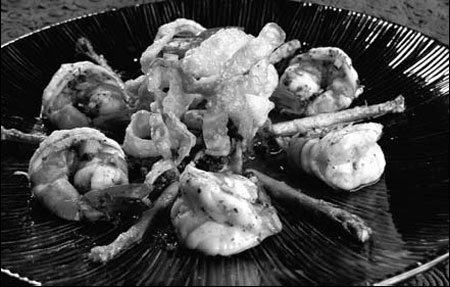
Stir-fried prawns with ji-zong mushrooms
The colorful ethnic heritage of Yunnan comes to Shanghai, showcased in a restaurant. Yu Ran samples the food.
The mysterious culture of China's ethnic minorities is served on the menu right along the signature dishes. This folk cuisine specialist located in the heart of Shanghai also signals its ability to take its diners on a tasty tour to Yunnan and beyond with its iconic dcor in red and gold, the vibrant colors of ethnic groups in Yunnan and its neighbor, Tibet.
Lost Heaven on the Bund mainly features the flavor from the Land South of the Clouds, as Yunnan is known, and its culinary range starts from the hill country of Burma and Thailand and head north to Tibet, roughly following the ancient Tea and Horse Caravan Route.
In times past, the famous teas of Yunnan were brought along mountainous paths to Tibet, where the precious cargo was exchanged for sturdy Tibetan horses.
"Mekong River cuisine, a rich blend of ingredients and preparation, is among the most palatable I have tasted. Every dish seems to have a hidden story," says Robin Yin, the owner of Lost Heaven.
Along the tea-horse trading trail, regional ingredients were also exchanged, including Yunnan pu-er tea, milk, lemongrass, chili peppers, exotic mushrooms, native plants, pickled vegetables and legumes. In return, cheese, potatoes and smoked meat from Tibet came south.
Along the route, too, the traders would have passed through the homesteads of more than 20 ethnic minority groups mainly Tibetan, Dai, Miao, Bai and Yi with their diverse culinary traditions.
Unlike their urban cousins, these minority groups have long subscribed to a sustainable cuisine, foraging in the wild for ingredients, both vegetable and animal.
"We do not use man-made additives in the cooking as the natural flavoring extracted from plants is the essence in our daily life. Cooking organic and traditional cuisine is our mission, and we want to pass on our ethnic dining culture to our customers," Teng Fushun, the chef of the restaurant says. He belongs to the Dai minority.
One example of the chef's ethnic heritage is Ancient Trail Crispy Pork, a dish traditionally prepared by caravan traders on the road. Slices of pork are fried before a sour and spicy sauce is poured on. It also keeps well, an important factor if you are traveling.
